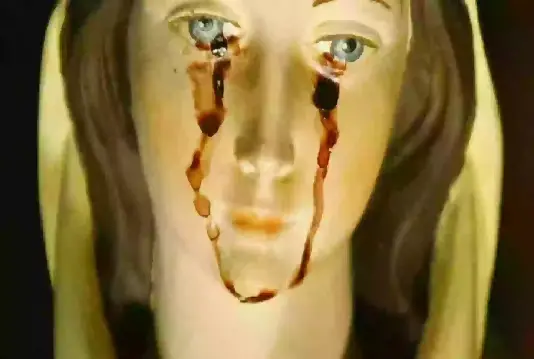In a case that has captivated both the religious community and the public at large, recent DNA testing results have provided new insights into a controversy surrounding a statue of the Virgin Mary reputed to weep tears of blood. The statue, which was purchased in 2016 by Gisella Cardia at a religious site in Medjugorje, Bosnia, later found a permanent home in Trevignano Romano, Italy. Over time, Cardia asserted that the statue not only wept tears of blood but also conveyed messages to her—claims that quickly attracted widespread attention and support from devout followers.
Background and Initial Claims
Gisella Cardia’s claims regarding the supernatural nature of the statue sparked considerable interest, drawing visitors who hoped to witness the phenomenon firsthand. According to Cardia, the statue’s miraculous behavior was genuine, and her experiences served as a testament to its divine origin. Her assertions were bolstered by the influx of donations from believers who saw in these events a reaffirmation of their faith. However, as the phenomenon garnered attention, it also attracted skepticism and prompted a thorough investigation into the authenticity of the claims.
The Investigation and Fraud Allegations
By 2023, suspicions about the statue’s miraculous attributes had intensified, leading prosecutors in Civitavecchia to initiate an investigation into possible fraudulent activities. Allegations emerged that the blood observed on the statue might not be of supernatural origin but rather could be pig’s blood, a claim that significantly undermined the purported miracle. In response to these allegations, authorities collected DNA swabs from the statue as part of their broader investigation into the incident.
DNA Test Results: What They Revealed
The initial round of DNA tests confirmed that the blood on the statue was human in origin, rather than originating from any animal source. However, further analyses revealed additional, more complex details. Laboratory tests conducted as part of the investigation found traces of Gisella Cardia’s DNA in the blood present on the statue. This finding has led to a heated debate among experts and legal representatives regarding the implications of the DNA evidence.
Cardia’s lawyer has contended that the presence of her DNA on the statue does not automatically invalidate the possibility of a miraculous occurrence. Instead, the lawyer suggests that the nature of the DNA profile—whether it is a single-profile or a mixed profile—is the key to understanding the situation. According to legal counsel, if the DNA profile is found to be a single one, indicating that it solely belongs to Cardia, it would suggest that the blood was introduced intentionally, supporting the fraud allegations. Conversely, if the DNA profile is mixed, it would be consistent with Cardia’s regular interactions with the statue, such as kissing and handling it, which could naturally result in traces of her DNA being present. This nuanced perspective highlights the complexity of interpreting forensic evidence in cases that straddle the boundaries between faith and science.
The Role of the Diocese of Civita Castellana
Parallel to the forensic investigations, the Diocese of Civita Castellana undertook its own inquiry into the claims of supernatural phenomena associated with the statue. In a statement released in May 2024 on behalf of Bishop Marco Salvi, the diocese clarified that after a period of “careful discernment” and extensive consultations with experts, the events in question were determined to be non-supernatural. The investigation was conducted by a commission of experts that included a Mariologist, a theologian, a canonist, a psychologist, and additional external specialists. This diverse panel reviewed testimonies, examined the historical and religious context of the statue, and engaged in fervent prayer, ultimately concluding that there was no evidence to support the claim of divine intervention.
The diocesan findings have added a significant layer of skepticism to Cardia’s assertions, suggesting that the miraculous events could be explained by natural causes or human intervention rather than by a supernatural phenomenon. This official stance has prompted further debate among both the faithful and the scientific community.
The Broader Implications for Faith and Science
This case sits at the intersection of faith, science, and the law, raising important questions about the evaluation of alleged miracles in the modern age. On one hand, faith-based narratives often hold deep emotional and spiritual significance for believers. On the other hand, scientific inquiry demands rigorous, empirical evidence to substantiate claims that defy conventional explanation. The DNA findings, therefore, serve as a potent reminder of the challenges involved in reconciling personal religious experiences with objective forensic data.
Supporters of Cardia argue that her actions and experiences are rooted in sincere belief, emphasizing that the presence of her DNA on the statue is a predictable consequence of her personal devotion. They maintain that her deep faith and commitment to the spiritual narrative surrounding the statue should not be dismissed solely on the basis of forensic evidence. Conversely, skeptics highlight that the evidence suggests possible manipulation and intentional deceit, underscoring the need for further investigation to definitively establish whether the phenomenon is authentic or fabricated.
Looking Ahead: The Need for Continued Investigation
Given the mixed nature of the forensic evidence, both legal and scientific experts agree that further investigation is necessary to reach a conclusive verdict. Determining whether the DNA profile found on the statue is a single or a mixed profile will be crucial. This detail could either lend credence to the fraud allegations or, alternatively, validate the natural occurrence of her DNA due to routine contact with the statue. Until these additional tests are completed and their results thoroughly analyzed, the controversy is likely to persist, fueling ongoing debates about the authenticity of miraculous events in contemporary religious contexts.
Conclusion
The case of the Virgin Mary statue that allegedly weeps tears of blood encapsulates the enduring tension between faith and empirical evidence. With recent DNA test results revealing traces of Gisella Cardia’s DNA on the statue, the narrative has taken an intriguing turn—one that underscores the importance of rigorous scientific inquiry in evaluating extraordinary claims. As investigations continue, both the faithful and the skeptical await further evidence that may either vindicate the claims of a divine miracle or confirm suspicions of human intervention. In the meantime, this case remains a fascinating example of how modern science is being applied to age-old questions about the nature of the miraculous, challenging us to consider how best to reconcile personal belief with objective analysis.

